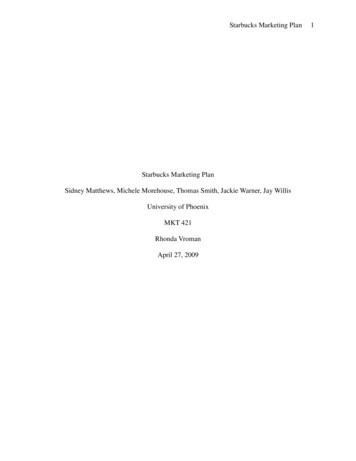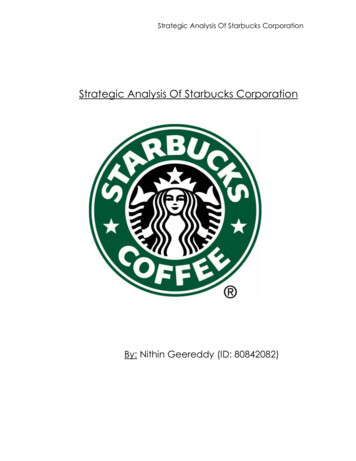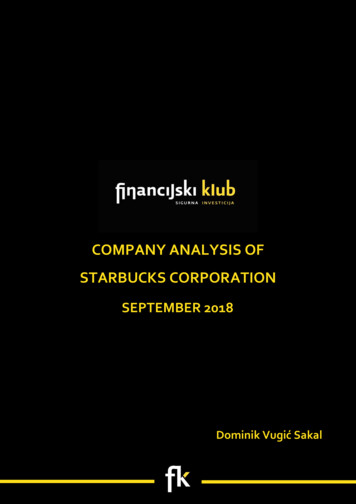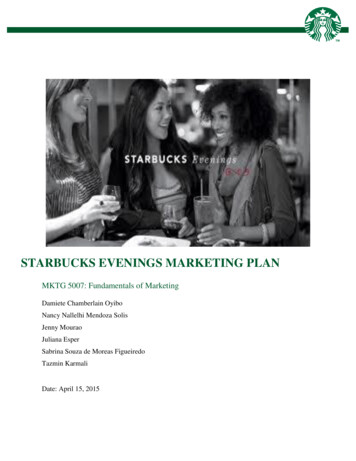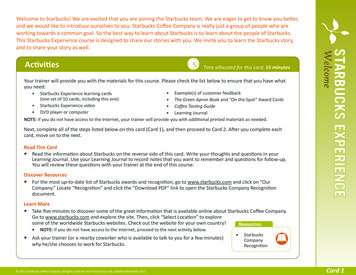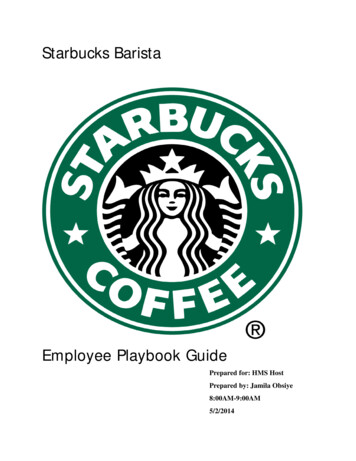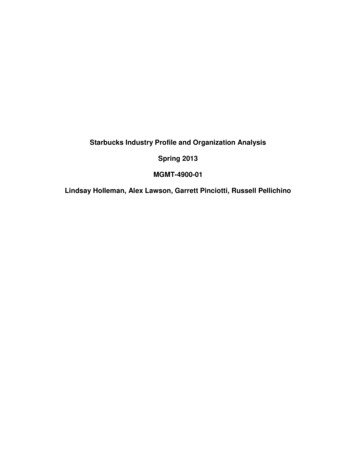
Transcription
Starbucks Industry Profile and Organization AnalysisSpring 2013MGMT-4900-01Lindsay Holleman, Alex Lawson, Garrett Pinciotti, Russell Pellichino
Starbucks 2Table of ContentsSection IEnvironmental Profile . 5Current Environment . 5Future Environment . 11Assessment of Relevancy . 13Section IIIndustry Profile . 14Historical Performance . 14Fast Food Industry. 14Coffee and Snack Shop Industry . 17Projected Performance. 17Fast Food Industry. 18Porter’s Five Forces . 19Rivalry Among Competitors . 20Potential Entry of New Competitors . 25Potential Development of Substitute Products. 31Bargaining Power of Buyers . 33Bargaining Power of Suppliers . 35Summary . 36Porter’s Industry Analysis Spreadsheet . 38Competitor Analysis . 40Local Coffee Distributors . 41
Starbucks 3Domestic Competitors . 42International Competitors . 43Competitive Behavioral Dynamics . 44Forecast of Future Industry Opportunities . 45Key Industry Success Factors . 47Five Years Ago to Now . 47Five Years Hence . 48Assessing Success Factors via Analytical Tools . 49Competitive Profile Matrix . 49External Factor Evaluation Matrix . 50Section IIIStarbucks Current Strategy . 51Customer Experience . 51Focus on Store Level Economics . 53Global Expansion . 54Streamlining Management . 55Current State of Starbucks’ Resources . 56Financial . 56Human Resources and Organizational Structure . 58Core Competencies. 60Internal Factor Evaluation . 61Value Chain Analysis . 64Primary Activities . 64
Starbucks 4Support Activities . 65Sustainable Competitive Advantage . 67Starbucks SWOT Analysis . 69Starbucks Strengths . 69Starbucks Weaknesses . 70Starbucks Opportunities . 72Starbucks Threats . 75SWOT Matrix . 77Competition’s SWOT Analysis . 78Competitors Strengths . 78Large Coffee Distributors Weaknesses . 80Small Coffee Shop Weaknesses . 81Large Coffee Distributors Opportunities . 82Local Coffee Shop Opportunities . 83Competitors’ Threats . 84Identification of Strategic Gaps in the Marketplace . 86Identification of Critical Success Factors and Measures . 87Choice of Future Competitive Strategy – Next Five Years . 90SPACE Matrix. 91Implementation Plan. 95Appendix . 97Exhibit 1 – Income Statement . 97Exhibit 2 – Balance Sheet . 98Exhibit 3 – Financial Ratios . 100References . 101
Starbucks 5Section I: Environmental profileIn and around any business are factors that play a role in the decisions,problems, and changes a company will face. Not all factors are controllable, however.These uncontrollable, external, factors range from the growing age of a predominantgeneration, to a new tax on international goods. They can take the form of social,cultural, demographic, environmental, political, legal, or technological forces.Whichever way, a business must be prepared to analyze and adapt to theirenvironment. For any industry, a company must look at the current environmentalsituations as well as predict the future environment.Current Environment:One of the biggest social concerns in the minds of people in the United Statesright now is the threat companies pose towards the environment and health of theplanet. People today want to have a “go green” mentality to help stop pollution,destruction of nature, and end global warming. In short, people want to improve thequality of life on a personal level, and therefore, expect the same on the corporate level.“Despite the growing concern over the long term side effects caused by criminalcorporate negligence, most corporations are still trying to do the least they can get awaywith,” (Fairbanks). Although this is not fact, it is an example of how consumers arethinking about the environment today and how they feel businesses are handling thesituation.Imagine how people with the same view would react to a public corporationconsistently trying to improve the environment. Would this company lose money? Yes.Would their future gains outweigh those losses? Absolutely. This can bring the practice
Starbucks 6of recycling, safe waste disposal, and even sparing water usage into businesseseverywhere. While this may seem to be a hassle at first, the respect gained fromconsumers will only sway them more to one particular company. Along the lines ofimproving upon the quality of life, people, women in particular, want similar qualityincreases in their workplace. A heavy weight has been placed on the human resourcedepartments to ensure this shift occurs within their companies respectively. Byincreasing the quality of work life, people will be more inclined to work harder and createproducts that are more efficient as a result.Another major factor in the social aspect of the environment is the need fordiversity. Having diversity in the workplace not only protects a company fromdiscrimination and legal attacks, but it also promotes the attraction of a diverse range ofconsumers. Bringing in different races of people will help reach out into differentsectors of the market. Race, however, is not the only factor in diversity. Women todayare making enormous strides for equality in the workforce. “ for example, [if] femaleemployment rates were to match male rates in the United States, overall GDP wouldrise by 5%,” (Hewlett). The quote stands for itself. Businesses would surely notcomplain if the GDP rose 5%. Not only the financial benefits women offer, but also theday-to-day interaction with consumers (given the company deals directly withconsumers) would be enriched with a woman’s perspective and common ways to relateto other women.Demographics are a major aspect to look at in the environment. For example,with 4.4 billion out of the 7 billion (“Current”), people in the world living on the continentof Asia, expansion into Asia is exactly what we are seeing in terms of outsourcing (at
Starbucks 7least from the United States). Furthermore, the number of Americans over the age of50 far exceeds the number of those under 50, (“Demographics”). This means that therewill be a younger workforce coming up to take the place of the baby-boomers. Alongwith age, comes the expected income. College graduates today envision a grand exitfrom college and straight into the real world with a big house, fast car, and plenty of fun.However, they will surely be shocked when they find out the road to that lifestyle will berough. The income of a college graduate, according to a study at the University ofMinnesota, stands at 44,259 ("Average”). Companies must understand theexpectations of these possible employees to better budget their money.The age of a person is good to know as well as how the numbers are changing.But, what about their families and how much they will be capable to work given theirother responsibilities? There are 71 million households of married families, 34 million ofthem with children under 18. On the contrary, there are 34 million households with onlyone owner (“Demographics”). These facts and numbers may seem useless if acompany does not think of the effects they may have on their employees. For instance,when hiring a woman with younger children, a business must be prepared to sacrificeproduction time expectations from her due to the unavoidable complications that comewith children. It is illegal to discriminate against a person with or without children;therefore businesses must be ready to make accommodations accordingly.Taking a look at any business, one thing they all have in common regardless oftheir industry is material needs. Location is critical to a business’s success. Placing aWal-Mart (just an example) in the middle of the rural farm area in the central part ofAlabama, between Mobile and Montgomery, would probably make a profit. However,
Starbucks 8placing a Wal-Mart in a suburb on the outskirts of either Mobile or Montgomery wouldmost likely generate a greater profit. According to “The Times 100: Business CaseStudies,” there are seven key attributes a company must look at to make a decision asto where to place a business, or even start a business:1. Market2. Raw Materials3. Transport costs4. Land5. Labor6. Safety7. Waste Disposal8. GovernmentAll of these are self-explanatory and can be easily expounded as to why they areimportant in the decision making process. However, the price tag on a few of them can,and most likely will, vary from place to place. This can be seen clearly in the decisionmany companies are making to outsource their labor and customer support centers.Moving many factories overseas cuts down on the cost of labor and ease of findingworkers. The same is true for finding people to take calls supporting, or complaining,about products sold to them by a company.“Governments control the business activities in many ways both direct andindirect,” (“Legal”). Government is most certainly one of the biggest factors in anenvironment that businesses must look at when doing an analysis. Government maypass laws to protect the interest of employees such as laws against unfair discriminationat work and when applying for jobs (“Legal”). Especially in the United States,discrimination is a big offense many corporations, both big and small, do not want toface. Legislations for health and safety at the workplace are also important to take into
Starbucks 9consideration. Here are a few examples of government regulations on businessoperations: Protecting workers from dangerous machinery Providing workers with proper safety equipment and clothing A reasonable workforce temperature is maintained for workers Washing facilities are provided Workers get adequate breaks between shiftsThese are only a few of a magnitude of government regulations that are placed onevery business in nearly every country in the world. On a smaller scale, regulating thecleanliness of a restaurant is a great example of how government agencies keep watchon businesses. All food-serving businesses must pass the proper inspections of theircooking, preparing, or serving stations before they can open and serve the public.Laws are passed by the government; therefore, there can be laws that affect abusiness’s means of operation, distribution, or selling of goods or services. Tax lawsare one mean for government regulation. Income tax, property tax, and federal taxes alltake a chunk out of the net income a company earns off their sales. Of the three, thecompany, based on where they
higher price; according to Michael Sauter from FoxBusiness, “Detroit’s cost per square foot of 62.45 was the lowest. San Francisco’s cost per square foot of 420.99 was the highest,” (Sauter). A business wanting an office building with the ground floor having 15,000 square feet would pay 3,000,000 today (given the price per square .




